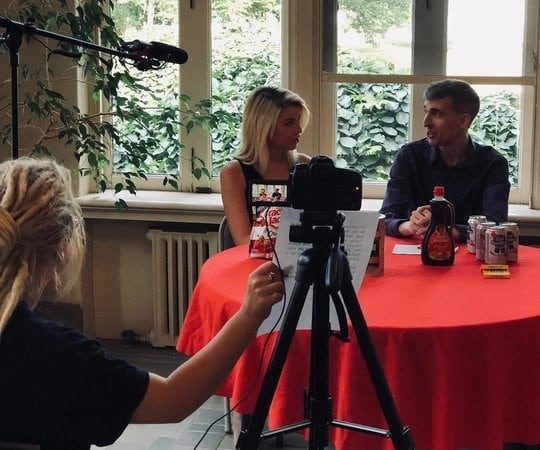
By Jarrett Zeman, Assistant Director and Curator, The 1890 House Museum, Cortland, NY
In 2018, the 1890 House Museum in Cortland, New York, debuted a YouTube series called WickWired, named for our house’s former owner, the inventor Chester Wickwire. Like any small museum, we have to find creative ways to do big projects on limited budgets. With YouTube, we saw an opportunity to engage our current audience, as well as attract new visitors, by creating videos that interpret our museum in new ways. A web series may seem like a peculiar fit for a rural house museum, but a small investment can pay big dividends when you increase the size of your community footprint.
Here are sixteen tips for creating an engaging YouTube series — without breaking the bank.
- Focus on stories beyond your main tour. Your YouTube channel shouldn’t replace a museum visit; rather, it should supplement your museum’s core narrative. In one video, we took viewers into spaces they don’t normally see: inside our attic, through a trapdoor, and underneath the stairs.
- Use your videos as a contextual tool. Have you ever led a tour and wished you could go into more detail about an object, person, or event? Here’s your chance! Videos are a great opportunity to focus on topics you can’t delve into on a normal tour. When you’re brainstorming topics, the first question should be: What can I put in context?
- Write down specific interpretive goals. An interpretive video can easily fly off the rails without tight organization — someone who’s asked to describe their favorite object might launch into a rambling dissertation, for example. Choose two to three interpretive goals to focus everyone’s mind. These goals become a crucial barometer once editing begins: if a line, shot, or scene doesn’t fit your interpretive goals, cut it — no matter how much you love it.
- Search for small details you can turn into big ideas. We know that the Wickwires visited the World’s Columbian Exposition in 1893, thanks to a newspaper announcement and a set of souvenirs. However, the Wickwires left no written record of their visit. We used the souvenirs as a framing device, and talked about the fair buildings those souvenirs came from. Along the way, we dealt with broader issues of race and class.
- Decide if your series will be scripted or improvised. Choose the style that fits your staff, budget, and audience. WickWired is a scripted series, because the polish that comes from carefully crafted writing fits our desired tone. However, you might choose to do your series as an improvised presentation, or as a guided conversation between two people. No matter which style you choose, make sure your format answers these questions: Is it engaging? Is it informative? Is it entertaining? Does it achieve specific interpretive goals?

Skip the memorizing by printing the script on cue cards. Have someone hold them directly underneath the camera, and it won’t look like you’re reading.
- YouTube is a modern tool, so give the content modern relevance. Relevance is the biggest buzzword in the field, for good reason. YouTube is a perfect opportunity to respond to our culture’s hottest issues. In a video called “The Hatpin Menace,” for example, we showed how Victorian women used hatpins to defend themselves against sexual assault, and made direct connections to the Me Too movement.
- Use your videos as a promotional tool. Theme your video around an upcoming event, and you’ll have a perfect conduit to plug your event without seeming heavy-handed. We did an episode on Victorian parlor games simply so we could promote a parlor game night. In addition to YouTube, post the latest video on your homepage. Each video acts as a free preview of your museum, and many guests have told us that they decided to visit our house as a result.
- Be brief. In the era of Snapchat, brevity is truly the soul of wit (and interpretation). Aim for videos that last no longer than five minutes, unless the topic demands a longer discussion.
- Choose a host that’s comfortable in front of a camera. Visitors will only engage with your content if the host is calm, confident, and comfortable. If a staff member or volunteer has experience on stage or on camera, ask them to be your host. If you have a college nearby, audition students from their Theatre or Communications departments who might be seeking portfolio pieces.

Videos are a unique project for an intern’s resume. Here, intern Amy Owren demonstrates food that debuted at the World’s Columbian Exposition.
- Utilize everyone (including your interns). While it’s important to have a good host, it’s prudent not to overuse them. With the right amount of coaxing, you can turn reluctant volunteers into willing actors. To convince nervous co-stars, give them limited dialogue, or non-verbal roles. In a video on dining room etiquette, our volunteers played members of a dinner party, but they did not have lines. If your host is responsible for the lion’s share of the talking, your co-stars will not shy away from the spotlight. Videos are an excellent way to give interns a standout project for their resume. Our interns assist with scriptwriting and filming, and WickWired is the project they look forward to the most each month.
- Vary the presentation style. Interpretation is a three-part harmony of content, audience, and method. Method is the most important of these: you can have great content, targeted to the right audience, but if the method is stale, people get bored. On WickWired, we use a variety of styles to tell our stories: we play parlor games, sing 1920s hits, and demonstrate period recipes. We also shot an episode in the style of a 1950s instructional video. Varying the style keeps your visitors curious about what you’ll do next.

We did our video on dining room etiquette in the style of a 1950s instructional video.
- Don’t be afraid to be funny. Anyone who’s given a tour knows that jokes are a tightrope act. Humor is subjective, and what earns a laugh from one group will get crickets from another. Few museums dip their toes into the comedy waters, for fear it will make them look unprofessional. This fear of funny is unfounded — humor chinks away at the stones propping up your museum’s ivory tower. Think about your favorite teacher in high school: was it the stuffy authority figure? It was probably the English teacher with the irreverent jokes. Humor can form the connective tissue of your video — if the jokes are good, people will watch for the entertainment value alone, and the learning happens by osmosis.
- Go beyond the confines of your museum. Field trips give viewers an opportunity to step outside the familiar halls of your museum. If there are any local sites connected to your story — a graveyard, a church, or even a street corner — they will enrich your visitors’ understanding of your story.
- Be transparent. Involve your audience by taking them behind-the-scenes. We always take a photograph during our video shoots, and post it to social media. The photograph teases the coming video, and our followers create buzz when they share it. We also produce blooper reels.
- Choose equipment that fits your budget. Our board president shot and edited our first video with nothing more than a handheld camera and iMovie, free on Apple computers. With the right person behind the camera, this setup is sufficient for videos of moderate-to-high quality. As our videos gained popularity, our board invested in the series. Today, we use a Canon 77D camera, a standard tripod, Final Cut Pro editing software, and a Rode mic with a boom (although a clip-on chest microphone works, too). This equipment has a one-time cost of $1,200. We record all voice-over narration at a local radio station, which provides studio space as a public service. To raise the necessary money for your YouTube series, consider making it the theme of one of your annual fundraisers, as this will give your audience a sense of ownership over the series.
- Be patient. Like anything digital, it takes time to build a following — we only had fifteen subscribers after our first three videos. It’s important to manage your expectations, especially at a small site. Ask your community partners to share your videos, and your subscribers will slowly grow. With strategic planning, guts, and an unfettered sense of fun, even a small museum can engage new audiences on YouTube.
WickWired, the YouTube series produced by the 1890 House Museum, can be found at: www.youtube.com/WickWired.



